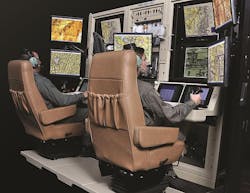Air Force orders unmanned aircraft flight simulation upgrades for practice and mission rehearsal
Officials of the Air Force Life Cycle Management Center at Wright-Patterson Air Force Base, Ohio, announced an $8.2 million order Monday to L-3 Link to provide communications kits for 40 fielded Block-30 Predator Mission Aircrew Training Systems (PMATS).
The L-3 Link PMATS is a sophisticated flight simulator that reproduces the aircrew ground stations of MQ-1 Predator and Predator B/MQ-9 Reaper combat drone pilots and sensor operators. The order also calls for L-3 Link to buy and install 40 sets of simulator seats.
The Predator and Reaper flight simulators enable students to master the art of flying and operating the Predator and Reaper UAVs using actual flight hardware. With PMATS, the level of realism between simulated exercises and real-world operations is transparent.
PMATS consists of a form, fit, and function user interface for the pilot and sensor operator stations and uses ground-control station (GCS) hardware from Predator and Reaper manufacturer General Atomics.
Related: Simulation and training experts Lockheed Martin and CAE to upgrade C-130J flight simulators
The General Atomics UAV flight-control equipment is integrated with the L-3 Link system hardware and software to produce high-fidelity training that models the General Atomics UAV systems, sensors, and weapons.
These flight simulators are for initial qualification and mission training, including emergency and abnormal procedures training. PMATS is integrated with instructional systems, including an instructor operator station (IOS) that supports crew training, monitoring, and evaluation.
The system provides training in stand-alone and local-area-network modes to enable either one pilot or several pilots to train together in the same building or vicinity. PMATS also can participate in the Air Force's Distributed Mission Operations (DMO) portal, enabling Predator and Reaper air crews to train together with other DMO-compliant platforms.
PMATS is available in a standalone configuration, which provides a dedicated training system; a PMATS appended system that uses an operational ground-control station for training and mission operations; and a PMATS lite system that provides low-cost, high-fidelity, dedicated training.
All three systems use actual Predator and Reaper hardware and software, as well as L-3's Blue Box High-definition (HD) training environment.
On this order L-3 Link will do the work in Arlington, Texas, and should be finished by June 2020. For more information contact L-3 Link Simulation & Training online at www.link.com, or the Air Force Life Cycle Management Center at www.wpafb.af.mil/aflcmc.
Ready to make a purchase? Search the Military & Aerospace Electronics Buyer's Guide for companies, new products, press releases, and videos

